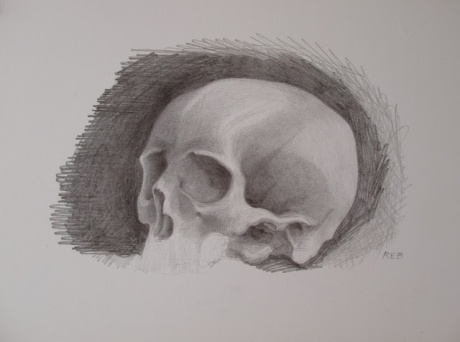
Tulip & Paperwhite Bulbs. silverpoint on prepared ground. 7.5×10″. 2012.
“Always be drawing and do not waste time.” – Michelangelo
“You have to practice even to be lousy.” – Jack Benny
The importance of drawing regularly — daily, even — is indispensable for the artist. Drawing is the most direct and personal method of working out ideas, developing discipline and coordination between the mind and the hand — the idea and the recording of it. The drawing above of flower bulbs is done in silverpoint, a really lovely medium I enjoy working in. Silverpoint is an early drawing medium that consists of a wire, about the same diameter as pencil lead, made of pure silver that is held in a stylus or handle, like an X-acto stencil knife handle. (I show three of mine below. The one I set into an old engravers tool handle is the most comfortable to hold.) It is used upon a prepared surface (ground) that has enough ‘tooth’ to allow the silver wire to leave faint scratch marks which are slowly built up and tarnish. I worked it pretty heavy to build up tones darker than what I am used to seeing in silverpoint. The current exhibit at the Metropolitan Museum of Art, The Renaissance Portrait from Donatello to Bellini, up through March 18, has some wonderful examples of metalpoint drawing and the sophisticated and subtle effects that can be obtained.
This time I prepared my own ground, made of fine marble dust and white pigment into a liquid binder of rabbit skin glue, applied in three layers on acid-free illustration board. Each layer took a few hours to dry thoroughly and I removed very rough bits and areas before applying the next coat. A light sanding provides a smooth surface but avoid breathing the dust.
New York artist Margaret Krug, author of An Artist’s Handbook, told me that she prepares a ground for her silverpoint drawings by combining zinc white pigment mixed into a watercolor binder, which is simple and economical and provides very beautiful results.
Silverpoint drawing supplies are available through mail-order from Natural Pigments of California.

[^ Above, three of my silverpoint drawings tools. Below, close-up of same. (L) 1.2mm diameter “dead soft” silver wire in an engravers tool handle salvaged from a flea market; (M) 2mm diameter “dead soft” silver wire in an Alvin lead holder; (R) 0.9mm diameter “dead soft” silver wire in an Alvin mechanical pencil.]

Visit Bullock Online: paintings and works on paper by Robert Edward Bullock.














